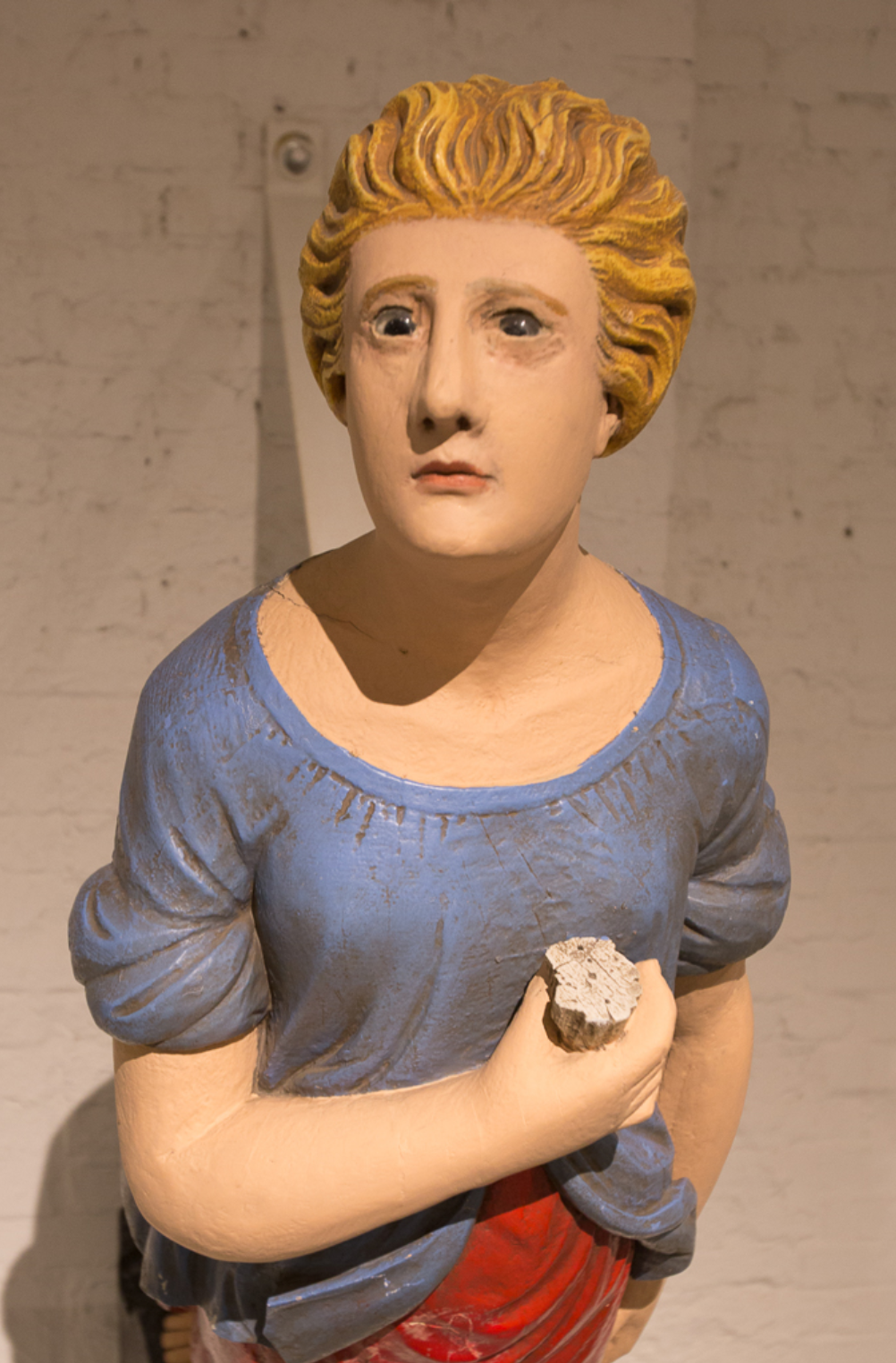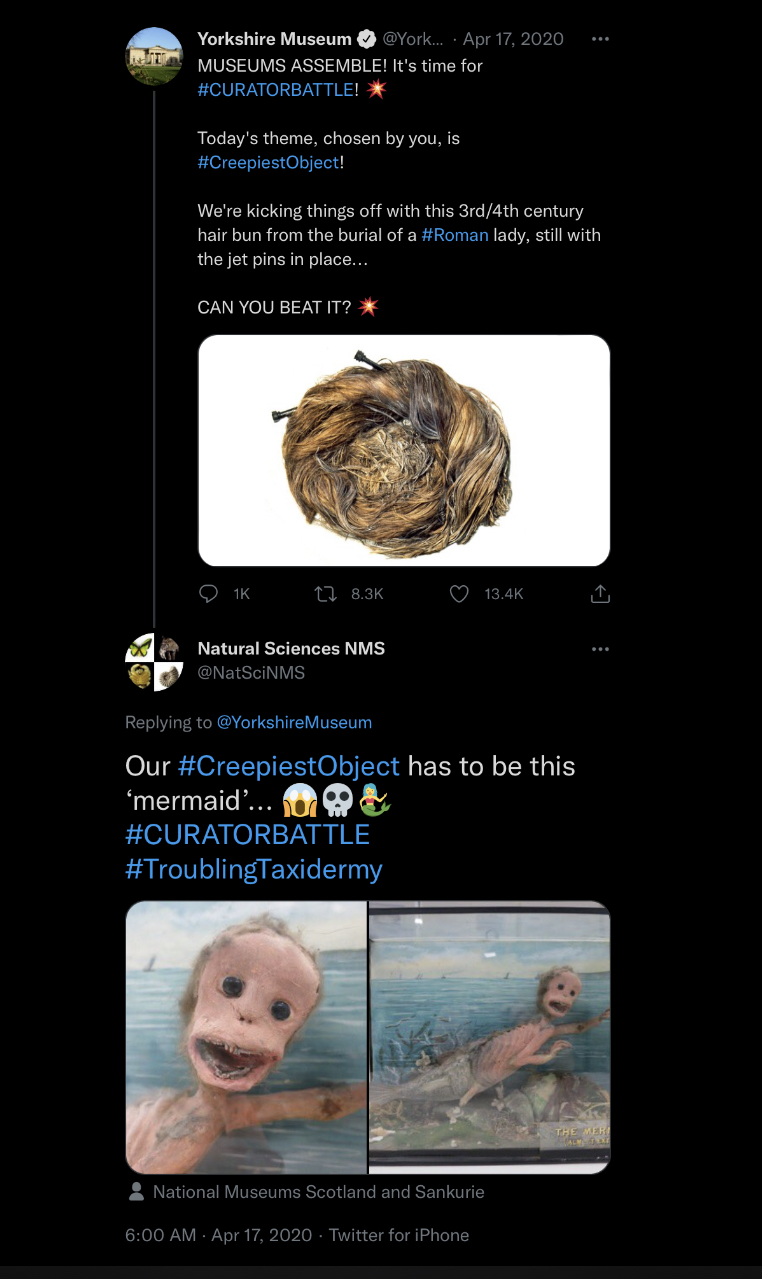Fear Not! For I have scoured The Mariners’ Collection, walked the dark storage rooms, and gotten up close and personal with five of our creepiest and most mysterious artifacts, so you don’t have to. I’ve listed the following artifacts for their varying levels of creep-factor or for the fascinating or mysterious stories behind them. All just in time for spooky season!
The Lady
In her heyday, the Lady figurehead sailed the open waters on a European vessel and arrived at the Museum in January 1982. She graced the walls of what was once The Great Hall of Steam until the Museum opened the Speed and Innovation exhibit. She’s not currently on display; however, her glass eyes and blank stare haunt our Collections Specialist from the workspace storage room. There’s just something unsettling about her…
Votive Model
Dating back to around the 15th century, sailors would often give churches votive models to show gratitude for a safe delivery after a perilous journey. We traditionally find these ships in Nordic churches, as well as some European countries such as Germany, the United Kingdom, France, and Spain. Our curators believed this particular model was created in the 19th century and is in the style of a 16th century Spanish Galleon ship. With the dark, weathered look of its wood and sails, and the religious iconography in the carvings and decorations, it looks like a ghost ship straight out of a movie! Luckily, you can see all these intricate details up close for yourself. Our grim galleon is on exhibit in our Ship Model Gallery!
Spare Parts Box from USS CYCLOPS
One of the most mysterious stories of naval history comes from the collier USS Cyclops. Cyclops operated with the Naval Auxiliary Service, Atlantic Fleet, in November 1910 with Lieutenant Commander George Worley in command. The vessel voyaged to the Baltics, then back to Norfolk, VA, operating on the east coast, servicing the fleet. Coincidently, Commander Worley and his wife lived in Norfolk. When the U.S. entered World War I, USS Cyclops was commissioned on May 1, 1917. Except for joining a convoy for Saint-Nazaire, France, in June 1917 and a short jaunt to Nova Scotia, Cyclops served the east coast once again until January 9, 1918. At that time, the Navy assigned Cyclops to Naval Overseas Transportation Service. The ship then sailed to Brazilian waters to fuel British ships in the south Atlantic. Cyclops left Rio de Janeiro on February 16, 1918, and entered Bahia, Brazil, on February 20.
Two days later, they set course for Baltimore, Maryland, carrying a load of 11,000 tons of manganese ore to use in munitions. Investigators believe the vessel was overloaded upon leaving Brazil, as the maximum capacity was 8,100 tons. Before leaving port, Commander Worley submitted a report that the starboard engine had a cracked cylinder and wasn’t operative. A survey board recommended the ship returns to the United States. They made an unscheduled stop in Barbados because the water was over the Plimsoll line, indicating an overloaded boat. However, investigations in Rio proved the ship was loaded and secured correctly. The next day they set out for Baltimore.
So what happened?
USS Cyclops would never make it to Maryland. Sometime after March 4, 1918, all 306 crew and passengers disappeared without a trace. No wreckage has ever been found. Some suggest that the combination of bad weather, overloaded conditions, and engine trouble may have contributed to USS Cyclops’ sinking. Although, an extensive naval investigation concluded: “Many theories have been advanced, but none that satisfactorily accounts for her disappearance.” However, the Navy wrote this statement before Cyclops’ sister ships Proteus and Nereus also disappeared at sea holding metallic ore. It’s similar to what Cyclops carried, and it’s far heavier than the coal these colliers usually hauled.
These disappearances could point to structural failures with this style of ship. However, more outlandish theories claim that all three ships were victims of the supernatural happenings within the Bermuda Triangle. Other views accused Lieutenant Commander Worley and one of the passengers, Alfred Louis Moreau Gottschalk, of being pro-German sympathizers. U.S. Barbados Consulate Charles Livingston discovered that Commander Worley was a German native who emigrated from Germany and changed his name. Livingston believed they collaborated with the Germans during WWI and handed over the ship. Investigations after the war checked German records to determine if Cyclops fell to a German submarine attack or by subterfuge through Worley. They found no evidence of either.
What about the box?
During the crew’s time in Virginia, before Cyclops went missing, a spare parts box from the ship somehow made its way into a private home in Norfolk. There it sat in the crawl space until the new homeowner found it in 1926. He then donated it to the Museum in 1941 when we officially accessioned it to our collection. However, we do not know who owned the house before the donor and there is no known connection between the donor and the ship. The trunk remains an eerie reminder of the tragedy that befell USS Cyclops. Outside of combat conditions, it remains the single largest loss of life in Naval history.
Ghost of Dunkirk
A British Lifeboat called Cyril, and Lilian Bishop is a little more fascinating than spooky. But I think you’ll soon understand why I included it on the list. The ship went into service in 1931 and spent four days and nights rescuing British and French soldiers during the WWI evacuation of Dunkirk. While our Cyril and Lilian Bishop is a scale model, the actual boat is 35 feet in length. These boats were stationed to shore posts in service to the Royal National Lifeboat Institution. They could stand up to heavy seas and are specially equipped to assist ships in states of emergency. Cyril and Lilian Bishop proved it, too – capsizing and self-righting during service in 1944.
In May 1940, the Royal Navy commandeered as many shallow draught vessels as possible for the evacuation of Dunkirk. Afterward, they found vast quantities of sand in the decks, footlocker, and mast head light. The vessel also ended up with two bullet holes in the bow and still remained afloat. The Cyril and Lilian Bishop rescued an estimated 850 evacuees per day at Dunkirk, and earned the nickname “Ghost of Dunkirk” because “she appeared like a ghost amongst the smoke and mist” during the evacuation. If there ever was a “Little boat that could,” it would be this one!
Vice-Admiral Nelson Figure
When asking other team members what they felt was the creepiest object in the Collection, they mentioned the Nelson figure more than any other object. He currently stands watch in his exhibit wearing replica clothing based on research of surviving clothing Nelson wore in his time. His hair color is based on his pigtail cut off after his death at the Battle of Trafalgar in 1805. It’s now in the Greenwich, England National Maritime Museum. Nelson’s head and body were modeled after a mask of his face, taken during his life in 1800 Vienna, Austria. Heinrich Fuger, John Hoppner, and William Beechey painted portraits the same year. All the attention to detail makes the figure incredibly lifelike. When walking through Nelson Touch, you might get the feeling that someone is watching you. And you might be right.
Ghostly Galleries
If you need more Museum spookiness, check out this behind-the-scenes blog post. With the galleries closed to the public last year and the lights low, you hear every creak and bump throughout the building. Seeing the Museum in a different light (literally and figuratively) adds to the spooky fun!
#CreepiestObject
The Mariners’ Museum and Park is not alone in the world of mysterious and creepy artifacts. Last year, a Twitter battle broke out amid the pandemic shutdown. Museums worldwide shared their creepiest object, and the ensuing images were…troubling to say the least. From plague masks to “Mermaids,” history is full of incredible and incredibly creepy things!
Now go explore and have a spooky and merry time!

